Pengcheng Li
Predicting Artificial Neural Network Representations to Learn Recognition Model for Music Identification from Brain Recordings
Dec 20, 2024Abstract:Recent studies have demonstrated that the representations of artificial neural networks (ANNs) can exhibit notable similarities to cortical representations when subjected to identical auditory sensory inputs. In these studies, the ability to predict cortical representations is probed by regressing from ANN representations to cortical representations. Building upon this concept, our approach reverses the direction of prediction: we utilize ANN representations as a supervisory signal to train recognition models using noisy brain recordings obtained through non-invasive measurements. Specifically, we focus on constructing a recognition model for music identification, where electroencephalography (EEG) brain recordings collected during music listening serve as input. By training an EEG recognition model to predict ANN representations-representations associated with music identification-we observed a substantial improvement in classification accuracy. This study introduces a novel approach to developing recognition models for brain recordings in response to external auditory stimuli. It holds promise for advancing brain-computer interfaces (BCI), neural decoding techniques, and our understanding of music cognition. Furthermore, it provides new insights into the relationship between auditory brain activity and ANN representations.
IDEAW: Robust Neural Audio Watermarking with Invertible Dual-Embedding
Sep 29, 2024



Abstract:The audio watermarking technique embeds messages into audio and accurately extracts messages from the watermarked audio. Traditional methods develop algorithms based on expert experience to embed watermarks into the time-domain or transform-domain of signals. With the development of deep neural networks, deep learning-based neural audio watermarking has emerged. Compared to traditional algorithms, neural audio watermarking achieves better robustness by considering various attacks during training. However, current neural watermarking methods suffer from low capacity and unsatisfactory imperceptibility. Additionally, the issue of watermark locating, which is extremely important and even more pronounced in neural audio watermarking, has not been adequately studied. In this paper, we design a dual-embedding watermarking model for efficient locating. We also consider the impact of the attack layer on the invertible neural network in robustness training, improving the model to enhance both its reasonableness and stability. Experiments show that the proposed model, IDEAW, can withstand various attacks with higher capacity and more efficient locating ability compared to existing methods.
TG-LLaVA: Text Guided LLaVA via Learnable Latent Embeddings
Sep 15, 2024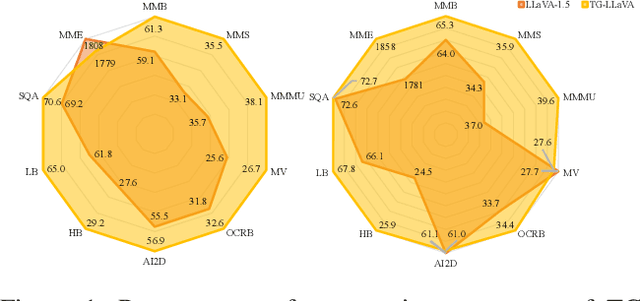
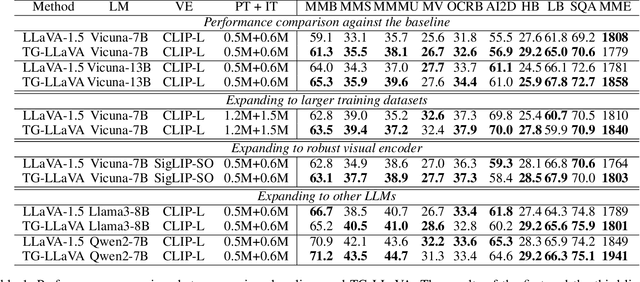
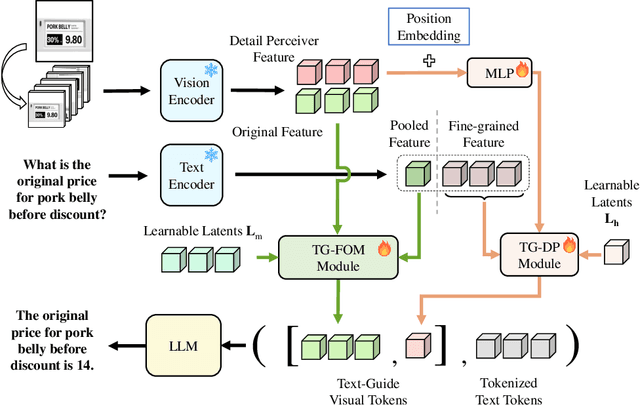

Abstract:Currently, inspired by the success of vision-language models (VLMs), an increasing number of researchers are focusing on improving VLMs and have achieved promising results. However, most existing methods concentrate on optimizing the connector and enhancing the language model component, while neglecting improvements to the vision encoder itself. In contrast, we propose Text Guided LLaVA (TG-LLaVA) in this paper, which optimizes VLMs by guiding the vision encoder with text, offering a new and orthogonal optimization direction. Specifically, inspired by the purpose-driven logic inherent in human behavior, we use learnable latent embeddings as a bridge to analyze textual instruction and add the analysis results to the vision encoder as guidance, refining it. Subsequently, another set of latent embeddings extracts additional detailed text-guided information from high-resolution local patches as auxiliary information. Finally, with the guidance of text, the vision encoder can extract text-related features, similar to how humans focus on the most relevant parts of an image when considering a question. This results in generating better answers. Experiments on various datasets validate the effectiveness of the proposed method. Remarkably, without the need for additional training data, our propsoed method can bring more benefits to the baseline (LLaVA-1.5) compared with other concurrent methods. Furthermore, the proposed method consistently brings improvement in different settings.
IVGF: The Fusion-Guided Infrared and Visible General Framework
Sep 02, 2024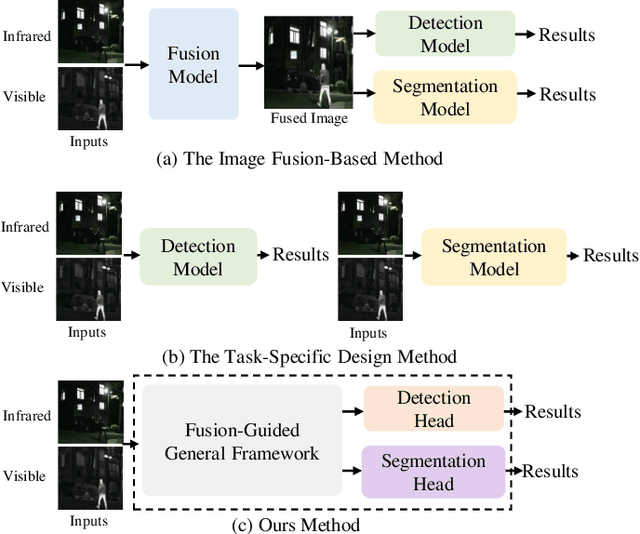
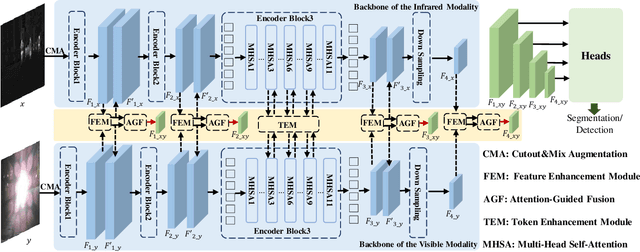
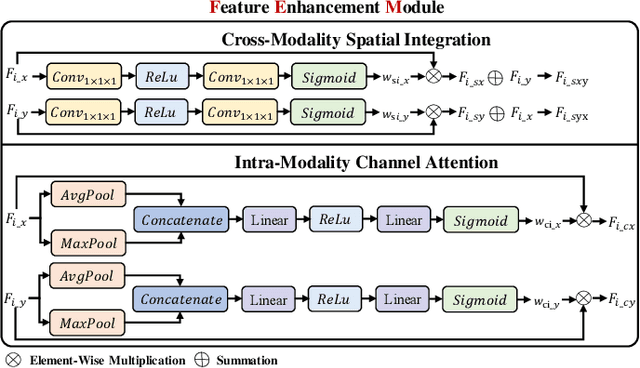

Abstract:Infrared and visible dual-modality tasks such as semantic segmentation and object detection can achieve robust performance even in extreme scenes by fusing complementary information. Most current methods design task-specific frameworks, which are limited in generalization across multiple tasks. In this paper, we propose a fusion-guided infrared and visible general framework, IVGF, which can be easily extended to many high-level vision tasks. Firstly, we adopt the SOTA infrared and visible foundation models to extract the general representations. Then, to enrich the semantics information of these general representations for high-level vision tasks, we design the feature enhancement module and token enhancement module for feature maps and tokens, respectively. Besides, the attention-guided fusion module is proposed for effectively fusing by exploring the complementary information of two modalities. Moreover, we also adopt the cutout&mix augmentation strategy to conduct the data augmentation, which further improves the ability of the model to mine the regional complementary between the two modalities. Extensive experiments show that the IVGF outperforms state-of-the-art dual-modality methods in the semantic segmentation and object detection tasks. The detailed ablation studies demonstrate the effectiveness of each module, and another experiment explores the anti-missing modality ability of the proposed method in the dual-modality semantic segmentation task.
Exploring Scene Coherence for Semi-Supervised 3D Semantic Segmentation
Aug 21, 2024



Abstract:Semi-supervised semantic segmentation, which efficiently addresses the limitation of acquiring dense annotations, is essential for 3D scene understanding. Most methods leverage the teacher model to generate pseudo labels, and then guide the learning of the student model on unlabeled scenes. However, they focus only on points with pseudo labels while directly overlooking points without pseudo labels, namely intra-scene inconsistency, leading to semantic ambiguity. Moreover, inter-scene correlation between labeled and unlabeled scenes contribute to transferring rich annotation information, yet this has not been explored for the semi-supervised tasks. To address these two problems, we propose to explore scene coherence for semi-supervised 3D semantic segmentation, dubbed CoScene. Inspired by the unstructured and unordered nature of the point clouds, our CoScene adopts the straightforward point erasure strategy to ensure the intra-scene consistency. Moreover, patch-based data augmentation is proposed to enhance the inter-scene information transfer between labeled and unlabeled scenes at both scene and instance levels. Extensive experimental results on SemanticKITTI and nuScenes show that our approach outperforms existing methods.
A Point-Neighborhood Learning Framework for Nasal Endoscope Image Segmentation
May 30, 2024Abstract:The lesion segmentation on endoscopic images is challenging due to its complex and ambiguous features. Fully-supervised deep learning segmentation methods can receive good performance based on entirely pixel-level labeled dataset but greatly increase experts' labeling burden. Semi-supervised and weakly supervised methods can ease labeling burden, but heavily strengthen the learning difficulty. To alleviate this difficulty, weakly semi-supervised segmentation adopts a new annotation protocol of adding a large number of point annotation samples into a few pixel-level annotation samples. However, existing methods only mine points' limited information while ignoring reliable prior surrounding the point annotations. In this paper, we propose a weakly semi-supervised method called Point-Neighborhood Learning (PNL) framework. To mine the prior of the pixels surrounding the annotated point, we transform a single-point annotation into a circular area named a point-neighborhood. We propose point-neighborhood supervision loss and pseudo-label scoring mechanism to enhance training supervision. Point-neighborhoods are also used to augment the data diversity. Our method greatly improves performance without changing the structure of segmentation network. Comprehensive experiments show the superiority of our method over the other existing methods, demonstrating its effectiveness in point-annotated medical images. The project code will be available on: https://github.com/ParryJay/PNL.
MAIN-VC: Lightweight Speech Representation Disentanglement for One-shot Voice Conversion
May 02, 2024Abstract:One-shot voice conversion aims to change the timbre of any source speech to match that of the unseen target speaker with only one speech sample. Existing methods face difficulties in satisfactory speech representation disentanglement and suffer from sizable networks as some of them leverage numerous complex modules for disentanglement. In this paper, we propose a model named MAIN-VC to effectively disentangle via a concise neural network. The proposed model utilizes Siamese encoders to learn clean representations, further enhanced by the designed mutual information estimator. The Siamese structure and the newly designed convolution module contribute to the lightweight of our model while ensuring performance in diverse voice conversion tasks. The experimental results show that the proposed model achieves comparable subjective scores and exhibits improvements in objective metrics compared to existing methods in a one-shot voice conversion scenario.
CONTUNER: Singing Voice Beautifying with Pitch and Expressiveness Condition
Apr 30, 2024Abstract:Singing voice beautifying is a novel task that has application value in people's daily life, aiming to correct the pitch of the singing voice and improve the expressiveness without changing the original timbre and content. Existing methods rely on paired data or only concentrate on the correction of pitch. However, professional songs and amateur songs from the same person are hard to obtain, and singing voice beautifying doesn't only contain pitch correction but other aspects like emotion and rhythm. Since we propose a fast and high-fidelity singing voice beautifying system called ConTuner, a diffusion model combined with the modified condition to generate the beautified Mel-spectrogram, where the modified condition is composed of optimized pitch and expressiveness. For pitch correction, we establish a mapping relationship from MIDI, spectrum envelope to pitch. To make amateur singing more expressive, we propose the expressiveness enhancer in the latent space to convert amateur vocal tone to professional. ConTuner achieves a satisfactory beautification effect on both Mandarin and English songs. Ablation study demonstrates that the expressiveness enhancer and generator-based accelerate method in ConTuner are effective.
Medical Speech Symptoms Classification via Disentangled Representation
Mar 08, 2024



Abstract:Intent is defined for understanding spoken language in existing works. Both textual features and acoustic features involved in medical speech contain intent, which is important for symptomatic diagnosis. In this paper, we propose a medical speech classification model named DRSC that automatically learns to disentangle intent and content representations from textual-acoustic data for classification. The intent representations of the text domain and the Mel-spectrogram domain are extracted via intent encoders, and then the reconstructed text feature and the Mel-spectrogram feature are obtained through two exchanges. After combining the intent from two domains into a joint representation, the integrated intent representation is fed into a decision layer for classification. Experimental results show that our model obtains an average accuracy rate of 95% in detecting 25 different medical symptoms.
DQR-TTS: Semi-supervised Text-to-speech Synthesis with Dynamic Quantized Representation
Nov 29, 2023



Abstract:Most existing neural-based text-to-speech methods rely on extensive datasets and face challenges under low-resource condition. In this paper, we introduce a novel semi-supervised text-to-speech synthesis model that learns from both paired and unpaired data to address this challenge. The key component of the proposed model is a dynamic quantized representation module, which is integrated into a sequential autoencoder. When given paired data, the module incorporates a trainable codebook that learns quantized representations under the supervision of the paired data. However, due to the limited paired data in low-resource scenario, these paired data are difficult to cover all phonemes. Then unpaired data is fed to expand the dynamic codebook by adding quantized representation vectors that are sufficiently distant from the existing ones during training. Experiments show that with less than 120 minutes of paired data, the proposed method outperforms existing methods in both subjective and objective metrics.
 Add to Chrome
Add to Chrome Add to Firefox
Add to Firefox Add to Edge
Add to Edge